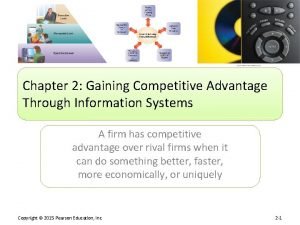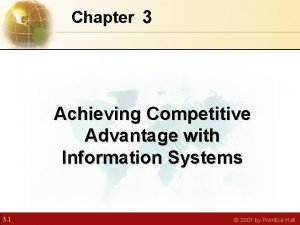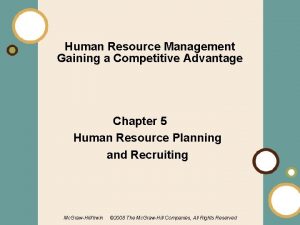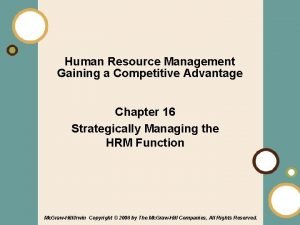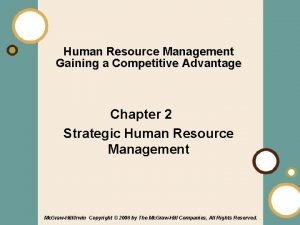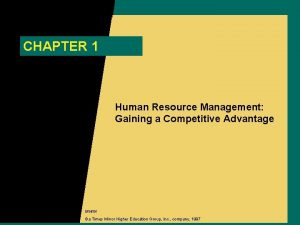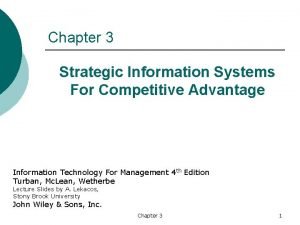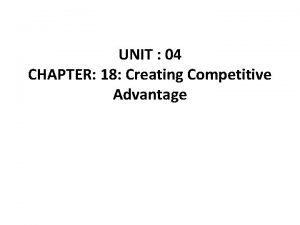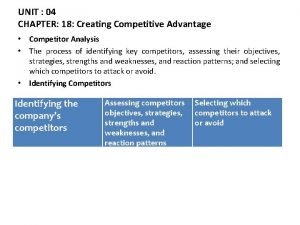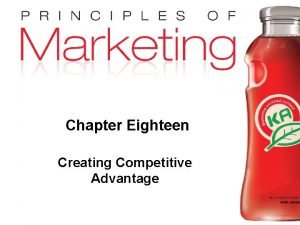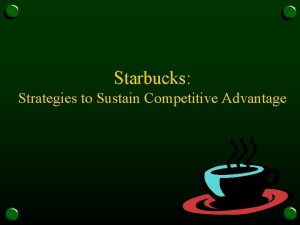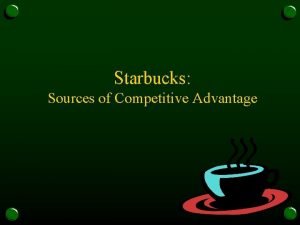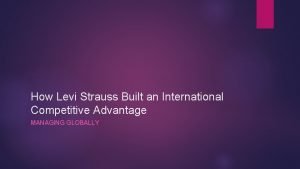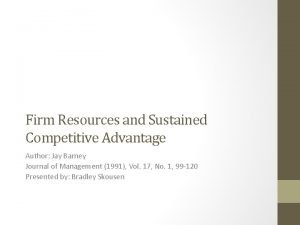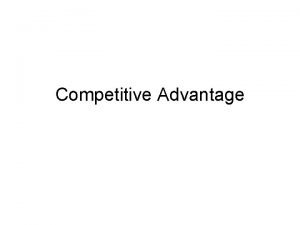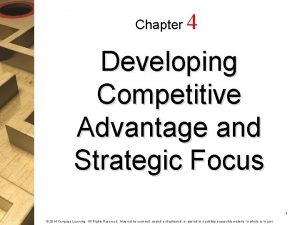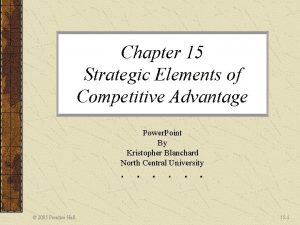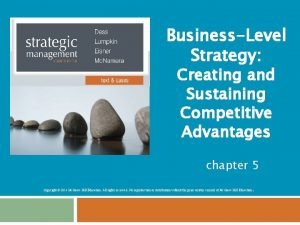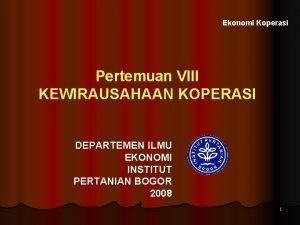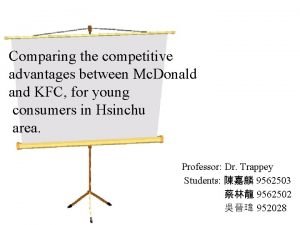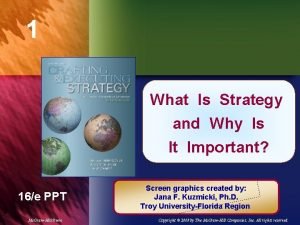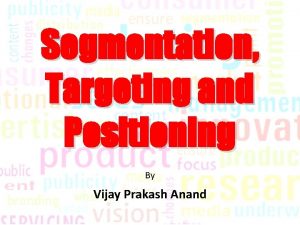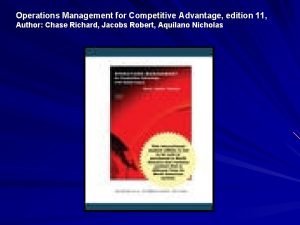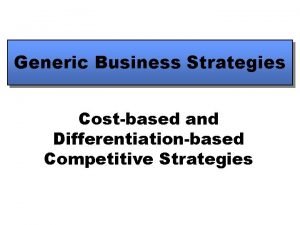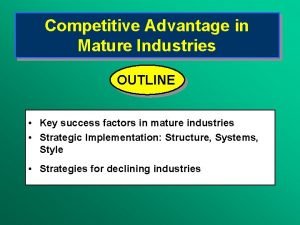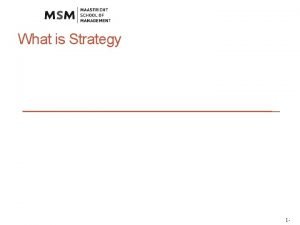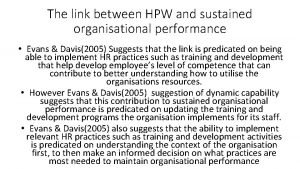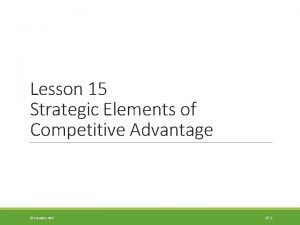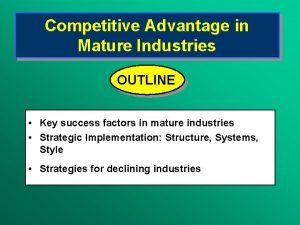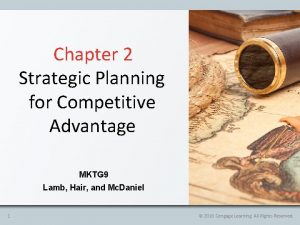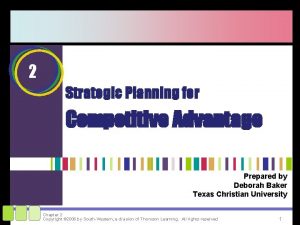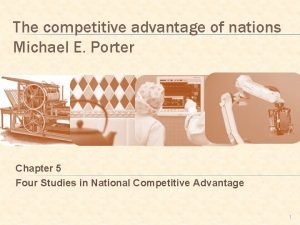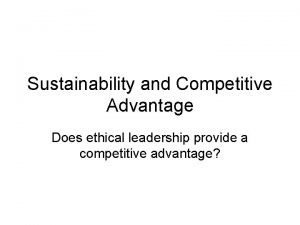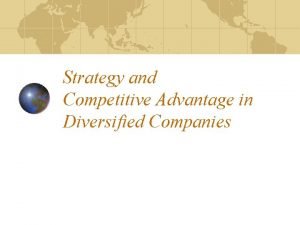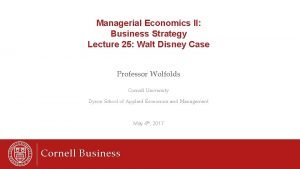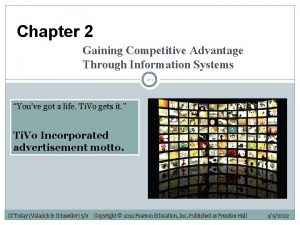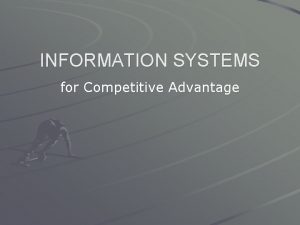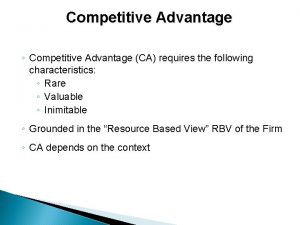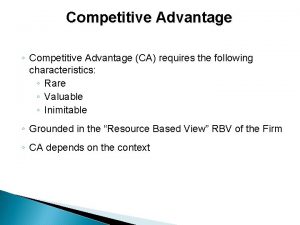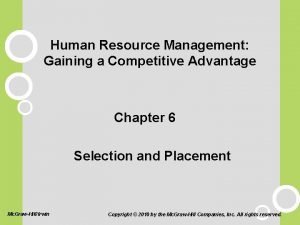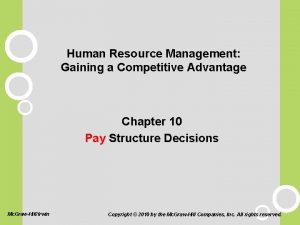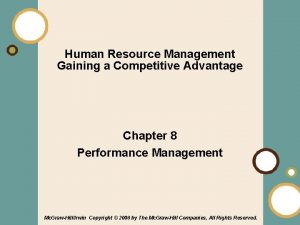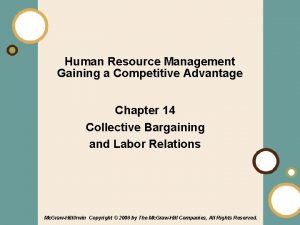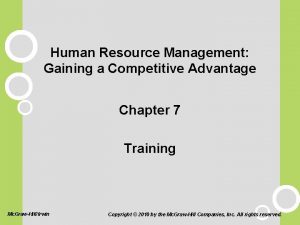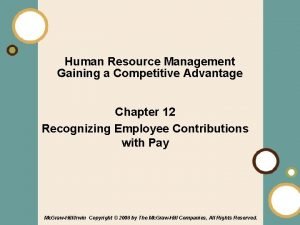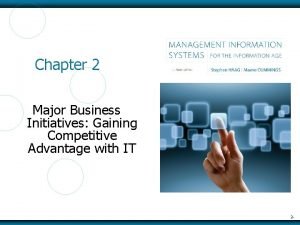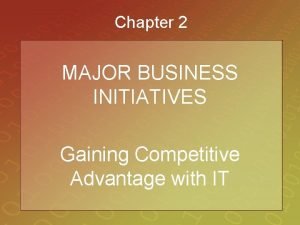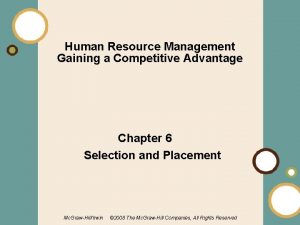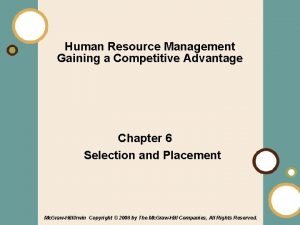Chapter 2 Gaining Competitive Advantage through Information Systems















































- Slides: 47

Chapter 2 - Gaining Competitive Advantage through Information Systems A firm has competitive advantage over rival firms when it can do something better, faster, more economically, or uniquely Copyright © 2014 Pearson Education, Inc. 1

Chapter 2 Learning Objectives Enabling Organizational Strategy through Information Systems • Discuss how information systems can be used for automation, organizational learning, and strategic advantage. International Business Strategies in the Digital World • Describe international business and IS strategies used by companies operating in the digital world. Valuing Innovations • Explain why and how companies are continually looking for innovative ways to use information systems for competitive advantage. Freeconomics: Why Free Products are the Future of the Digital World • Describe freeconomics and how organizations can leverage digital technologies to provide free goods and services to customers as a business strategy for gaining a competitive advantage. Copyright © 2014 Pearson Education, Inc. 2

Enabling Organizational Strategy through Information Systems Discuss how information systems can be used for automation, organizational learning, and strategic advantage. International Business Strategies in the Digital World Describe international business and IS strategies used by companies operating in the digital world. Valuing Innovations Explain why and how companies are continually looking for innovative ways to use information systems for competitive advantage. Freeconomics: Why Free Products are the Future of the Digital World Describe freeconomics and how organizations can leverage digital technologies to provide free goods and services to customers as a business strategy for gaining a competitive advantage. Copyright © 2014 Pearson Education, Inc. 3

Organizational Decision-Making Levels • Executive/Strategic Level – Upper Management • Managerial/Tactical Level – Middle Management • Operational Level – Operational Employees, Foremen, Supervisors Copyright © 2014 Pearson Education, Inc. 4

Organizational Decision-Making Levels: Operational Level Copyright © 2014 Pearson Education, Inc. 5

Organizational Decision-Making Levels: Managerial/Tactical Level Copyright © 2014 Pearson Education, Inc. 6

Organizational Decision-Making Levels: Executive/Strategic Level Copyright © 2014 Pearson Education, Inc. 7

Organizational Functions and Functional Levels Copyright © 2014 Pearson Education, Inc. 8

Information Systems for Automating: Doing Things Faster Primary Activities of Loan Processing Manual Loan Process Technology. Supported Fully Automated Complete and submit Completed at application home (1. 5 days) Completed at home Completed online (1. 5 days) (15 minutes) Check application for errors Done in batches (2. 5 days) Computerized (3. 5 sec) Input data into the information system NA some paper handling (1 hr) Done in batches (2. 5 days) NA (already done) Assess loan apps under $250 K Done by hand (15 days) Computer assisted (1 hr) Computer processed (1 sec) Committee decides if loan over $250 k (15 days) Applicant notified Batches (5 days) (1 day) E-mail (3. 5 sec) Total time 25 to 40 days 5 to 20 days 15 min to 15 days Copyright © 2014 Pearson Education, Inc. 9

Information Systems for Organizational Learning: Doing Things Better • Information systems can track and identify trends and seasonality • Managers can use this to plan staffing levels and cross-training Copyright © 2014 Pearson Education, Inc. 10

Information Systems for Supporting Strategy: Doing Things Smarter • Firms have a competitive strategy • Information Systems should be implemented that support that strategy – Low cost strategy implies information systems to minimize expenses – High quality strategy implies information systems to support ensuring excellent quality and minimal defects Copyright © 2014 Pearson Education, Inc. 11

Sources of Competitive Advantage Copyright © 2014 Pearson Education, Inc. 12

Identifying Where to Compete: Analyzing Competitive Forces Copyright © 2014 Pearson Education, Inc. 13

Using IS to Combat Competitive Forces Table 2. 2 Competitive Force Implication for Firm Potential Use of Information Systems Rivals within your industry Competition in price, product distribution, and service Reduce costs, use the Internet to increase service New entrants Reduced prices and market share Inventory control to manage excess capacity, Internet to differentiate products Customers’ bargaining power Reduced prices, demand for better quality and service CRM to improve service, CAD/CAM Suppliers’ bargaining power Increased costs and reduced quality Use internet to work with new distant suppliers Threat of substitute Decreased market share, products customer loss Copyright © 2014 Pearson Education, Inc. Better assess customer needs, use CAD to design better products 14

Identifying How to Compete: Analyzing the Value Chain Copyright © 2014 Pearson Education, Inc. 15

The Technology/Strategy Fit • There are never enough resources to implement every possible IS improvement • There are usually never enough resources to implement every financially beneficial IS improvement • Companies that focus on the improvements and business process changes that help their value creation strategy the most will see the greatest competitive benefit Copyright © 2014 Pearson Education, Inc. 16

Assessing Value for the IS Infrastructure • Economic Value – Direct financial impact • Architectural Value – Extending business capabilities today and in the future • Operational Value – Enhancing ability to meet business requirements • Regulatory and Compliance Value – Complying with regulatory requirements Copyright © 2014 Pearson Education, Inc. 17

Putting It All Together: Developing a Successful Business Model • A business model reflects the following: 1. What does a company do? 2. How does a company uniquely do it? 3. In what way (or ways) does the company get paid for doing it? 4. What are the key resources and activities needed? 5. What are the costs involved? Copyright © 2014 Pearson Education, Inc. 18

International Business Strategies in the Digital World Enabling Organizational Strategy through Information Systems Discuss how information systems can be used for automation, organizational learning, and strategic advantage. International Business Strategies in the Digital World Describe international business and IS strategies used by companies operating in the digital world. Valuing Innovations Explain why and how companies are continually looking for innovative ways to use information systems for competitive advantage. Freeconomics: Why Free Products are the Future of the Digital World Describe freeconomics and how organizations can leverage digital technologies to provide free goods and services to customers as a business strategy for gaining a competitive advantage. Copyright © 2014 Pearson Education, Inc. 19

International IS Strategies • There are four international business strategies – Home Replication – Global – Multidomestic – Transnational • Each has pros and cons in terms of complexity, cost benefits, local responsiveness, and control Copyright © 2014 Pearson Education, Inc. 20

Home-Replication Strategy • Focused Domestically • Exporting products to generate additional sales • Secondary emphasis on international operations • Information Systems not a significant factor in facilitating international export sales Copyright © 2014 Pearson Education, Inc. 21

Global Business Strategy Copyright © 2014 Pearson Education, Inc. 22

Multidomestic Business Strategy Copyright © 2014 Pearson Education, Inc. 23

Transnational Business Strategy Copyright © 2014 Pearson Education, Inc. 24

Valuing Innovations Enabling Organizational Strategy through Information Systems Discuss how information systems can be used for automation, organizational learning, and strategic advantage. International Business Strategies in the Digital World Describe international business and IS strategies used by companies operating in the digital world. Valuing Innovations Explain why and how companies are continually looking for innovative ways to use information systems for competitive advantage. Freeconomics: Why Free Products are the Future of the Digital World Describe freeconomics and how organizations can leverage digital technologies to provide free goods and services to customers as a business strategy for gaining a competitive advantage. Copyright © 2014 Pearson Education, Inc. 25

The Need for Constant IS Innovation “The most important discoveries of the next 50 years are likely to be ones of which we cannot now even conceive” John Maddox • Transformation Technologies are difficult or even impossible to see coming – Think of the Internet in 1999 – Many of the critical discoveries in the next 50 years will be in areas we don’t see coming Copyright © 2014 Pearson Education, Inc. 26

Successful Innovation Is Difficult • Innovation Is Often Fleeting – The pace of change is fast – Smart rivals quickly adopt any advantage • Innovation Is Often Risky – Competing Technologies result in a winner and a looser (e. g. : Blu-Ray and HD DVD) • Innovation Choices Are Often Difficult – It is impossible to pursue all opportunities – It is hard to predict which opportunities will lead to success Copyright © 2014 Pearson Education, Inc. 27

Organizational Requirements for Innovation • Process Requirements – Focus on success over other objectives • Resource Requirements – Employees with knowledge, skill, time & resources – Partner with appropriate requirements • Risk Tolerance Requirements – Tolerance for risk – Tolerance for failure Copyright © 2014 Pearson Education, Inc. 28

Predicting the Next New Thing • Many innovations can be copied – Limited time span of any advantage – May become a requirement for staying competitive • Some innovations deliver longer advantages – Unique customer service based on customer data – High levels of customer investment in proprietary systems – high switching costs – Technologies that are very difficult to copy Copyright © 2014 Pearson Education, Inc. 29

The Diffusion of Innovations Copyright © 2014 Pearson Education, Inc. 30

Disruptive Innovations Examples from Table 2. 8 Disruptive Innovation Displaced or Marginalized Technology Digital photography Chemical photography Online stock brokerage Full-service stock brokerages Online retailing Brick-and-mortar retailing Distance education Classroom education Unmanned aircraft Manned aircraft Semiconductors Vacuum tubes MP 3 players and music downloading Compact discs and music stores Smartphones MP 3 players, dedicated GPS navigation Tablets Notebook computers Copyright © 2014 Pearson Education, Inc. 31

The Innovator’s Dilemma Copyright © 2014 Pearson Education, Inc. 32

Executing Innovation Copyright © 2014 Pearson Education, Inc. 33

Freeconomics: Why Free Products are the Future of the Digital World Enabling Organizational Strategy through Information Systems Discuss how information systems can be used for automation, organizational learning, and strategic advantage. International Business Strategies in the Digital World Describe international business and IS strategies used by companies operating in the digital world. Valuing Innovations Explain why and how companies are continually looking for innovative ways to use information systems for competitive advantage. Freeconomics: Why Free Products are the Future of the Digital World Describe freeconomics and how organizations can leverage digital technologies to provide free goods and services to customers as a business strategy for gaining a competitive advantage. Copyright © 2014 Pearson Education, Inc. 34

How Freeconomics Works Copyright © 2014 Pearson Education, Inc. 35

The Freeconomics Value Proposition • Free doesn’t mean no profit – Google gives away search – Users give Google search results their attention • This can include attention to sponsored links • Google sells space for sponsored links – Advertisers pay Google for that attention to sponsored links • Some users convert into customers • Customers pay advertising firms for their products Copyright © 2014 Pearson Education, Inc. 36

Applying Freeconomics in the Digital World Approach What it Means Examples Advertising Free services are provided to customers & paid for by a third party ▪ Yahoo!’s banner ads ▪ Google’s pay-per-click Freemium Basic services are free, a premium is charged for special features ▪ Skype ▪ Dropbox. com Cross subsidies Sale price of one item is reduced in order to sell something else of value ▪ Free cell phone with twoyear contract Zero Marginal Cost Products are distributed to customers without an appreciable cost to anyone ▪ i. Tunes music distribution ▪ Software distribution ▪ You. Tube Video content Labor Exchange The act of customers using free services creates value ▪ Yahoo! Answers ▪ Answers. com Gift Economy People participate and collaborate to create value for Everyone ▪ Open source software ▪ Wikipedia Copyright © 2014 Pearson Education, Inc. 37

END OF CHAPTER CONTENT Copyright © 2014 Pearson Education, Inc. 38

Managing in the Digital World: The Business of Merging “Groups” and “Coupons” • Groupon created a new business model – Heavily discounted deals for grouped buyers – Advertising value for sellers • Groupon’s business model is easily duplicated, and has been, repeatedly – Groupon does have a first mover head start – Groupon has purchased many competitors – However, Groupon has no sustainable competitive advantage as currently positioned Copyright © 2014 Pearson Education, Inc. 39

Brief Case: For Sale By Owner: Your Company’s Name. com • Domain names can be purchased by anyone, whether they own the trademark for that name or not – Businesses have had to pay premium prices for their own trademarked names – Legislation to prevent Domain Squatting has stalled in congress – Some names are rented to businesses for lucrative amounts – Common misspellings now lead to advertising sites Copyright © 2014 Pearson Education, Inc. 40

When things go wrong: The Pains of Miscalculating Groupon • Groupon sales are heavily discounted, and can cost companies more then they bring in – Groupon takes 40% of the discounted sale – Groupon sales unprofitable unless they grow the repeat business customer base – Some sales are one-time (eye laser surgery) – Businesses forget to cap the number of sales – A large number of unprofitable sales can lead to large losses for small companies Copyright © 2014 Pearson Education, Inc. 41

Who’s Going Mobile: Mobile Operating Systems • Market share battle • Rapid growth in cell phone operating systems • Market share can change rapidly • Some Operating Systems are proprietary, but Google took an open approach with Android Copyright © 2014 Pearson Education, Inc. 42

Coming Attractions: Google’s Project Glass: A Pair of Glasses • Project Glass: an embedded display in eyeglasses • Augments reality – Displays time/space relevant information • • Current schedule Directions Weather forecasts Information about what is being looked at • Still under development / research Copyright © 2014 Pearson Education, Inc. 43

Key Players: The Global Elite Largest Non-US Based Technology Companies Rank World Rank Company 2011 Sales (US$ m) HQ Founded Primary Markets 1 1 Samsung 133, 780 South Korea 1969 Electronics, IT 2 3 NTT 124, 330 Japan 1985 Telecomm 3 5 Hitachi 112, 400 Japan 1910 IT, Telecomm, Other 4 9 Panasonic 104, 880 Japan 1918 Electronics 5 10 Siemens 96, 590 Germany 1847 Electronics, Engineering 6 11 Sony 86, 640 Japan 1946 Electronics 7 12 Deutsche Telekom 82, 650 Germany 1996 Telecomm 8 13 Telefónica 80, 830(2010) Spain Telecomm Copyright © 2014 Pearson Education, Inc. 1924 44

Ethical Dilemma: Underground Gaming Economy • Virtual worlds have virtual economies with goods and currency (often virtual gold) – Players are now buying and selling virtual goods with real money – Some companies hire people to ‘farm gold’ which they sell • Estimated 400, 000 gold farmers world wide • 90% in China, often work 12 hour days – Buying assets in a game creates advantages over players who can’t or won’t, changing the game – Some companies ban gold farmers for life to protect the integrity of the game for other players Copyright © 2014 Pearson Education, Inc. 45

Industry Analysis: Banking Industry • With 1970 s banking deregulation, banks can operate across state lines and internationally • Online banking is now the norm • Mobile banking is rapidly growing • Industry in a state of transition • Security concerns remain Copyright © 2014 Pearson Education, Inc. 46

Copyright © 2014 Pearson Education, Inc. 47
 Gaining competitive advantage through information systems
Gaining competitive advantage through information systems Achieving competitive advantage with information systems
Achieving competitive advantage with information systems Human resource management gaining a competitive advantage
Human resource management gaining a competitive advantage Human resource management gaining a competitive advantage
Human resource management gaining a competitive advantage Human resource management gaining a competitive advantage
Human resource management gaining a competitive advantage Human resource management gaining a competitive advantage
Human resource management gaining a competitive advantage One way linkage hrm
One way linkage hrm Human resource management gaining a competitive advantage
Human resource management gaining a competitive advantage Information system for competitive advantage in mis
Information system for competitive advantage in mis Standard cycle market example
Standard cycle market example What is timber conversion
What is timber conversion Chapter 18 creating competitive advantage
Chapter 18 creating competitive advantage Chapter 18 creating competitive advantage
Chapter 18 creating competitive advantage Chapter 2 strategic planning for competitive advantage
Chapter 2 strategic planning for competitive advantage Chapter 18 creating competitive advantage
Chapter 18 creating competitive advantage Chapter 18 creating competitive advantage
Chapter 18 creating competitive advantage Least competitive market
Least competitive market Competitive and non competitive antagonist
Competitive and non competitive antagonist Vrio jay barney
Vrio jay barney Competitive advantage of starbucks
Competitive advantage of starbucks Starbucks resources and capabilities
Starbucks resources and capabilities Levi's competitive advantage
Levi's competitive advantage Firm resources and sustained competitive advantage
Firm resources and sustained competitive advantage Quotes on competitive advantage
Quotes on competitive advantage Bases of competitive advantage
Bases of competitive advantage Generic building blocks of competitive advantage
Generic building blocks of competitive advantage Developing competitive advantage and strategic focus
Developing competitive advantage and strategic focus Elements of competitive advantage
Elements of competitive advantage Creating and sustaining competitive advantage
Creating and sustaining competitive advantage Mis competitive advantage
Mis competitive advantage Strategic planning for competitive advantage
Strategic planning for competitive advantage Competitive advantage pada koperasi
Competitive advantage pada koperasi Competitive advantage of kfc
Competitive advantage of kfc A company strategy and its quest for competitive advantage
A company strategy and its quest for competitive advantage Psychographic segmentation of nivea
Psychographic segmentation of nivea Operations management for competitive advantage
Operations management for competitive advantage A differentiation-based competitive advantage
A differentiation-based competitive advantage Mature industry
Mature industry Ibm mission statement
Ibm mission statement Benefits of hpw
Benefits of hpw Searching for loose bricks
Searching for loose bricks Competitive advantage in mature industries
Competitive advantage in mature industries Strategic planning for competitive advantage
Strategic planning for competitive advantage Strategic planning for competitive advantage
Strategic planning for competitive advantage Competitive advantage of nations summary
Competitive advantage of nations summary Sustainable competitive advantage examples
Sustainable competitive advantage examples Related and unrelated diversification
Related and unrelated diversification Disney competitive advantage
Disney competitive advantage
